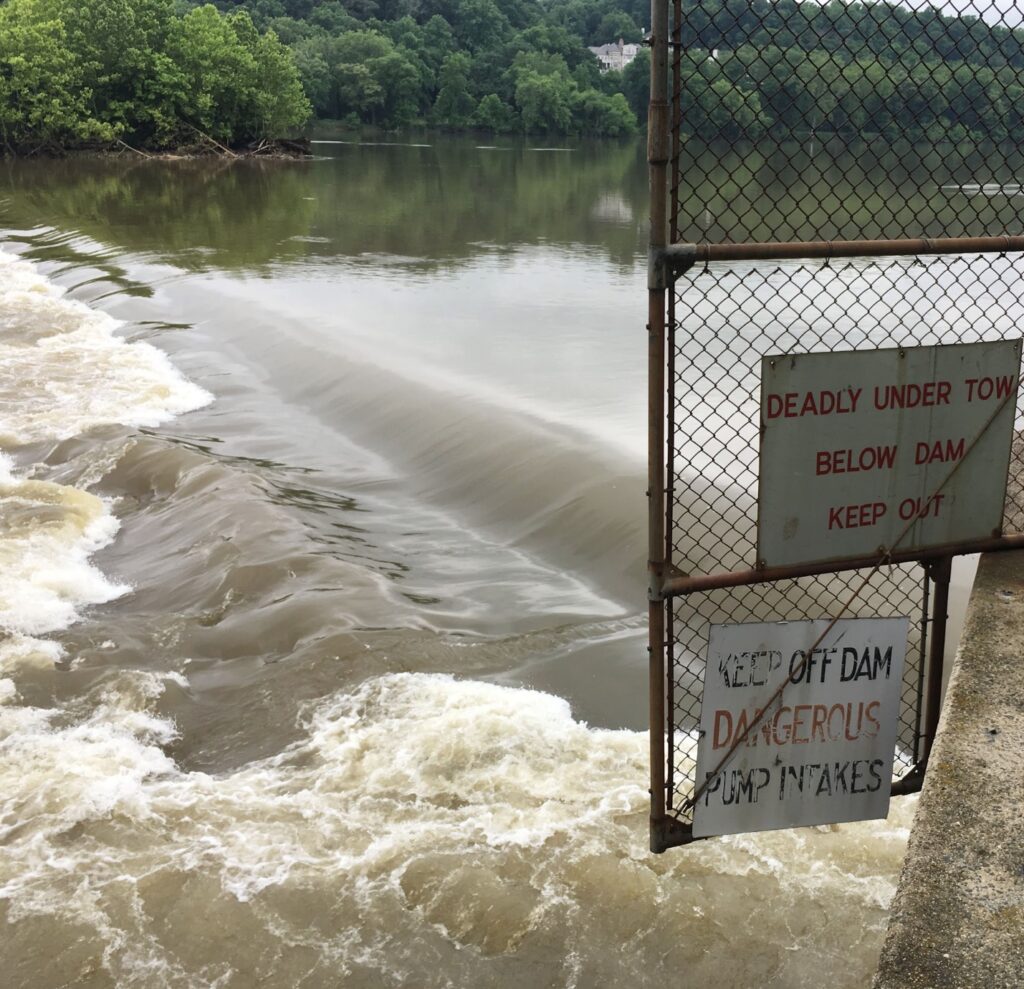Some of my earliest memories of whitewater kayaking involve my mom waking me up early in the morning, my teenage self lazily walking to her car, and falling right back asleep in the passenger’s seat during the over two-hour-long car ride to Richmond, Virginia. When the Richmond section of the James River floods above eleven feet, a surf wave comes into play that attracts paddlers from all around. Memories of paddling here with my mom include endless flat spins, cramming paddlers in a line like sardines to see how many people fit on the river-long feature, and adrenaline rushing through my veins.
Another river wave I grew up surfing is just twenty minutes away from my house on the Potomac River. Like the wave in Richmond, it is only surfable at higher water levels. Another thing these waves have in common? They are both created by low head dams.
Low head dams are shorter structures where water continuously flows over the crest of the dam. At most water levels, this creates a washing machine-like hydraulic at the base of the dam that can trap and kill swimmers, paddlers, and rescuers. Although I went out on the river when I knew the water was high enough to wash out this hydraulic, my time with American Rivers this summer has opened my eyes to the harsh reality of low head dams.
Let’s work together to prioritize safe and healthy rivers
Join us in signing this petition to tell Congress that funding for public safety, river restoration, and clean water is important to ensure healthy rivers for future generations.
My lifelong love for paddling inspired me to begin my internship with American Rivers. Immediately, I dove into the world of low head dam safety and regulations following the fatality of a park ranger at a low head dam in Pennsylvania. Low head dams were originally built for local needs such as water supply, powering mills, or irrigation, but many of these dams no longer serve a public purpose. Because most are less than fifteen feet tall, many states do not regulate them, exempting them from inspections and safety requirements.
The dams are deceiving to the eye; when looking downstream at a low head dam, their flat horizon lines often blend in with the river, making them almost invisible to see and very easy to miss. I soon realized that the occasional faded sign stating “Keep out, low head dam” fails to prevent the more than 1,400 fatalities that have occurred at these “drowning machines,” and approximately 50 additional fatalities occur each year. I learned that more than 20 people have passed away at Z Dam, and over 15 at Brookmont Dam, the two dams that I have learned to surf at during high water. I also discovered that low head dams are underregulated nationally, increasing the imminent threat to public safety in communities. Not only are they a threat to safety, but in a world facing the climate crisis, they disrupt aquatic ecosystems, fish passage, and river flow. Low head dams are a hazard to the public, boaters, and the environment alike.
As an experienced whitewater kayaker, I have gained a deep knowledge of river hydraulics and appreciation for river safety. This transfers to informed paddling at certain features. Clashing emotions occur; enjoying a surf session, but at a man-made dam that has taken numerous lives. How can one reconcile with a non-natural, persistent threat to public safety while relishing in a perfect surf on a rare river wave?

Greater public awareness of low head dam hazards is the first step in facing this dilemma. Understanding how low head dams are unsafe and supporting stricter regulation and removal can begin to change this life-threatening problem. During my internship, I identified which states have safety regulations or educational materials on low head dams, such as Indiana, Pennsylvania, and Virginia. I worked with a team to advocate for increased safety and community awareness at these dams and a smoother path to removing low head dams that are no longer necessary.
As a kayaker, I feel a strong responsibility to advocate for the protection of rivers and nearby communities. Using our unique knowledge of rivers, we can work to inform communities of the dangers of these dams. Even though there are some boaters who feel connected to a certain infrequent surf spot, or a swimming hole below a low head dam, free-flowing rivers are better for everyone: public safety, ecosystems, and recreation.
Think hard about your local lowhead dam or check the National Inventory of Low Head Dams if you do not know if there is one near you. Picture what this low, river-wide structure looks like, and the sound of the water flowing down its subtle yet consequential drop. Now think about the same spot if the impoundment were not there. Think about the possibility of more fish, more recreation, and increased safety. Imagine the river in its natural state, the river flowing freely, no deadly barrier in its way.
This is an attainable future if we continue to fight for it.
As for epic surf waves, there are plenty of natural waves on rivers across the country and abroad. My mom and I continue to find them and surf them. It is always more fun to get out on free-flowing rivers together.


